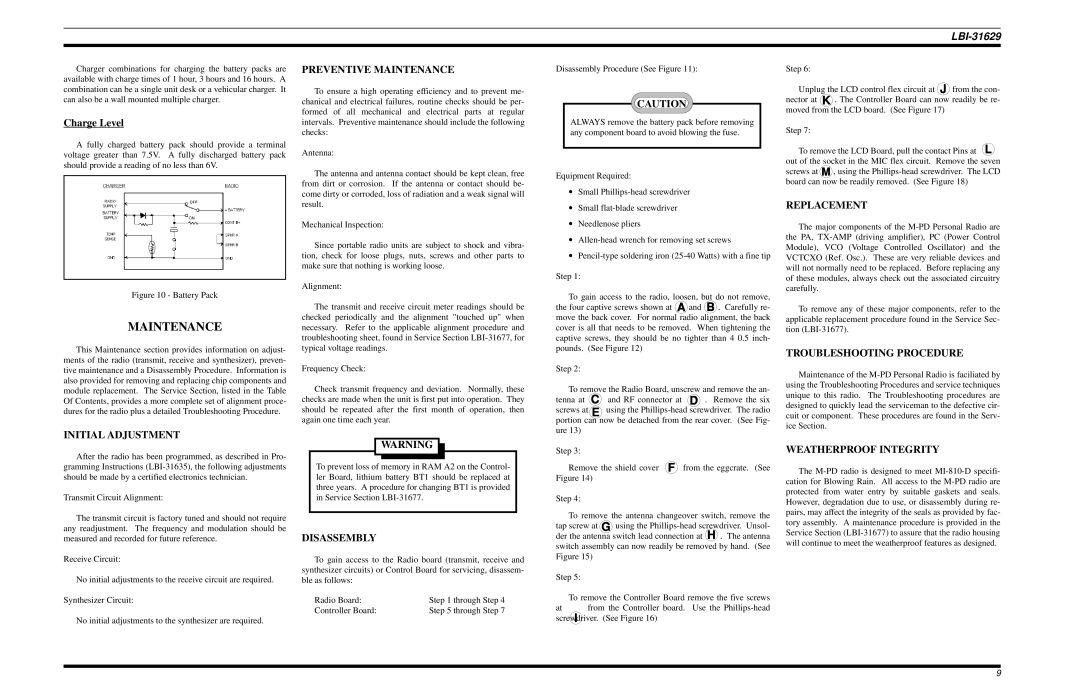
LBI-31629
Charger combinations for charging the battery packs are available with charge times of 1 hour, 3 hours and 16 hours. A combination can be a single unit desk or a vehicular charger. It can also be a wall mounted multiple charger.
Charge Level
A fully charged battery pack should provide a terminal voltage greater than 7.5V. A fully discharged battery pack should provide a reading of no less than 6V.
Figure 10 - Battery Pack
MAINTENANCE
This Maintenance section provides information on adjust- ments of the radio (transmit, receive and synthesizer), preven- tive maintenance and a Disassembly Procedure. Information is also provided for removing and replacing chip components and module replacement. The Service Section, listed in the Table Of Contents, provides a more complete set of alignment proce- dures for the radio plus a detailed Troubleshooting Procedure.
INITIAL ADJUSTMENT
After the radio has been programmed, as described in Pro- gramming Instructions
Transmit Circuit Alignment:
The transmit circuit is factory tuned and should not require any readjustment. The frequency and modulation should be measured and recorded for future reference.
Receive Circuit:
No initial adjustments to the receive circuit are required.
Synthesizer Circuit:
No initial adjustments to the synthesizer are required.
PREVENTIVE MAINTENANCE
To ensure a high operating efficiency and to prevent me- chanical and electrical failures, routine checks should be per- formed of all mechanical and electrical parts at regular intervals. Preventive maintenance should include the following checks:
Antenna:
The antenna and antenna contact should be kept clean, free from dirt or corrosion. If the antenna or contact should be- come dirty or corroded, loss of radiation and a weak signal will result.
Mechanical Inspection:
Since portable radio units are subject to shock and vibra- tion, check for loose plugs, nuts, screws and other parts to make sure that nothing is working loose.
Alignment:
The transmit and receive circuit meter readings should be checked periodically and the alignment "touched up" when necessary. Refer to the applicable alignment procedure and troubleshooting sheet, found in Service Section
Frequency Check:
Check transmit frequency and deviation. Normally, these checks are made when the unit is first put into operation. They should be repeated after the first month of operation, then again one time each year.
WARNING |
To prevent loss of memory in RAM A2 on the Control- ler Board, lithium battery BT1 should be replaced at three years. A procedure for changing BT1 is provided in Service Section
DISASSEMBLY
To gain access to the Radio board (transmit, receive and synthesizer circuits) or Control Board for servicing, disassem- ble as follows:
Radio Board: | Step 1 through Step 4 |
Controller Board: | Step 5 through Step 7 |
Disassembly Procedure (See Figure 11):
CAUTION
ALWAYS remove the battery pack before removing any component board to avoid blowing the fuse.
Equipment Required:
∙Small
∙Small
∙Needlenose pliers
∙
∙
Step 1:
To gain access to the radio, loosen, but do not remove,
the four captive screws shown at ![]() and
and ![]()
![]() . Carefully re- move the back cover. For normal radio alignment, the back cover is all that needs to be removed. When tightening the captive screws, they should be no tighter than 4 0.5 inch- pounds. (See Figure 12)
. Carefully re- move the back cover. For normal radio alignment, the back cover is all that needs to be removed. When tightening the captive screws, they should be no tighter than 4 0.5 inch- pounds. (See Figure 12)
Step 2:
To remove the Radio Board, unscrew and remove the an-
tenna at ![]()
![]() and RF connector at
and RF connector at ![]()
![]() . Remove the six
. Remove the six
screws at ![]()
![]()
![]() using the
using the
Step 3:
Remove the shield cover ![]()
![]() from the eggcrate. (See Figure 14)
from the eggcrate. (See Figure 14)
Step 4:
To remove the antenna changeover switch, remove the
tap screw at ![]()
![]() using the
using the
der the antenna switch lead connection at ![]()
![]() . The antenna switch assembly can now readily be removed by hand. (See Figure 15)
. The antenna switch assembly can now readily be removed by hand. (See Figure 15)
Step 5:
To remove the Controller Board remove the five screws
at from the Controller board. Use the
Step 6:
Unplug the LCD control flex circuit at ![]() from the con-
from the con-
nector at ![]() . The Controller Board can now readily be re- moved from the LCD board. (See Figure 17)
. The Controller Board can now readily be re- moved from the LCD board. (See Figure 17)
Step 7:
To remove the LCD Board, pull the contact Pins at ![]()
![]() out of the socket in the MIC flex circuit. Remove the seven
out of the socket in the MIC flex circuit. Remove the seven
screws at ![]() , using the
, using the
REPLACEMENT
The major components of the
To remove any of these major components, refer to the applicable replacement procedure found in the Service Sec- tion
TROUBLESHOOTING PROCEDURE
Maintenance of the
WEATHERPROOF INTEGRITY
The
9
